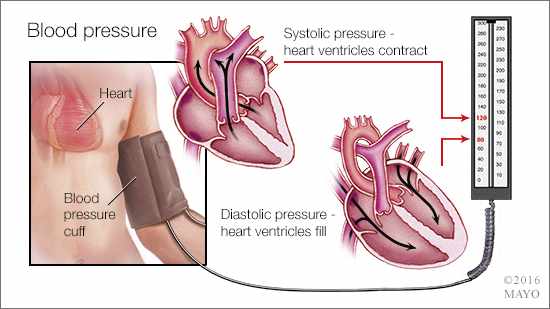-
Cardiovascular
Mayo Clinic Q and A: Low Blood Pressure

DEAR MAYO CLINIC: What is considered “low” for the diastolic number in a blood pressure reading? What would a low reading mean? If the systolic number is within normal range, what can be done to alter the diastolic number?
ANSWER: A blood pressure reading has two numbers, given in millimeters of mercury. The first, or upper, number measures the pressure in your arteries when your heart beats. That’s systolic pressure. The second, or lower, number measures the pressure in your arteries between beats. That’s the diastolic pressure.
In general, diastolic blood pressure is considered to be low if it is 60 millimeters of mercury or less. Normal blood pressure varies from one person to another though. If your diastolic blood pressure is consistently below 60 millimeters of mercury, but you aren’t experiencing any problems from it, you may not need to do anything. Noticeable symptoms of low blood pressure generally include dizziness, lightheadedness or fainting. If you’re having these or other symptoms that could be related to low blood pressure, more investigation may be required to uncover the possible cause and provide appropriate treatment.
In some cases, medications can cause low diastolic blood pressure. In particular, medications intended to lower blood pressure, called anti-hypertensives, may go too far in the other direction, reducing blood pressure beyond a healthy level. These anti-hypertensives include diuretics (sometimes called water pills), alpha blockers and beta blockers. Other medications also may lead to low blood pressure, such as drugs for Parkinson’s disease, certain types of antidepressants, and the drug sildenafil, particularly in combination with heart medication (e.g., nitroglycerine).
An underlying medical condition could trigger low blood pressure, as well. For example, heart problems, such as extremely low heart rate, heart valve problems and heart failure, may cause low blood pressure, because they prevent the body from being able to circulate enough blood. Endocrine disorders, such as adrenal insufficiency, also can trigger low blood pressure.
Other conditions, including dehydration, blood loss, severe infection and a severe allergic reaction, can lead to low blood pressure. But, these disorders usually cause a sudden, dramatic drop in pressure, rather than a sustained low blood pressure reading over time.
Another possible cause for low diastolic blood pressure is extremely stiff arteries. Very often, around 55 to 60 years of age, arteries begin to lose some of their flexibility. That can increase systolic blood pressure and cause discordantly low diastolic blood pressure. In some cases, however, stiff arteries could be a symptom of vascular disease.
When your diastolic blood pressure is consistently below normal, it may need to be evaluated. In young healthy people who do not take medications or have any symptoms, no treatment may be needed. But, it’s still a good idea to talk to your doctor about it. If you do take medications, ask your doctor to review your current medication list to see if they could be contributing to low blood pressure.
If your doctor suspects that an underlying disorder could be the source of the problem, then additional tests may be necessary. It also would be worthwhile to talk with your doctor about managing any vascular risk factors you may have that can be changed, such as smoking, high cholesterol, diabetes and obesity. When a medical condition leads to low diastolic blood pressure, successfully treating that problem may eliminate the low blood pressure, too. — Dr. Sandra Herrmann, Nephrology, Mayo Clinic, Rochester, Minnesota







